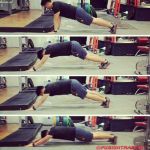
Upper Crossed Syndrome:
While the term sounds all fancy, it’s actually quite simple. The term was developed by Dr. Janda, “Upper Crossed Syndrome”, is the typical desk worker that has a hunched over body and the head tipping forward:

If you go back to the ‘Janda Figure 1’ and focus on the top ‘X’, you’ll see the terms ‘facilitated’ and ‘inhibited’. This simply mean the Pecs are “over-active” or “too tight” and thus pulling you forward, which in turns “:inhibits” or weakens the lower trap/serratus anterior.
Let’s Keep It Simple
I don’t want to bore you guys with all the terminology, so just know that for the desk worker (generally speaking) you’d want to stretch and work on the soft tissues quality of the pecs and upper trap and also address lower trap/serratus anterior inhibition by strengthening them.
Take Home Asignment:
Work on soft tissue quality of the Pecs:
Once you’re done, I’d suggest to “activate” the posterior muscles via Wall Slides:
After the wall slides, you should do a Pec Stretch:
Reciprocal inhibition tells us that when one side is active the opposite side must relax. For this instance, the wall slides activate the “postural” muscles, hence the pec should relax, therefore when you stretch, you should get a “deeper” stretch!
Conclusion:
The end premise here is to strengthen the “Inhibited” muscles, and stretch the “Facilitated” muscles. To be blunt, stop focusing on just the bench, add in some pull ups, rows, posterior delt exercises and STRETCH, you meat head! I say this with love 🙂
 About the Author
About the Author







Speak Your Mind